A stately pleasure-dome decree:
Where Alph, the sacred river, ran
Through caverns measureless to man
Down to a sunless sea.
 The often-quoted opening stanza of Samuel Taylor Coleridge's poem Kubla Khan paints a picture of the glories of China's great Yuan Dynasty (1271-1368) under the world-conquering Mongol ruler. The center of this wonder world was Shangdu, or Xanadu as Marco Polo pronounced it, and the remains are there to be seen today in Inner Mongolia autonomous region.
The often-quoted opening stanza of Samuel Taylor Coleridge's poem Kubla Khan paints a picture of the glories of China's great Yuan Dynasty (1271-1368) under the world-conquering Mongol ruler. The center of this wonder world was Shangdu, or Xanadu as Marco Polo pronounced it, and the remains are there to be seen today in Inner Mongolia autonomous region.
Considering the wealth Kublai's grandfather Genghis had passed down, and the additional riches Kublai accumulated, Shangdu could have been the richest city the world had ever seen.
When I visited the ruins of the old capital, 350 km north of Beijing, I gazed over the grassy plain and let my imagination run as wild as the horses galloping in the nearby grasslands.
I was standing where Marco Polo would have stood, where he marveled at the man-made majesty of the world's biggest ever empire. The conquering Khans surpassed everybody - Alexander the Great, the Romans, the Rockefellers, everybody. They were the richest family in history, and if their wealth was converted in today's currency, could buy Warren Buffett out many times over.
Chinese visitors to the site talk of undiscovered buried riches. As tourists walked over the grassy ruins, they said many people had tried to find the treasure, but to no avail. They said thousands of Japanese soldiers in the 1930s had used metal detectors and searched rigorously to unearth the hidden bounty but could not find a thing.
To me, Kublai's missing treasure conspiracy makes sense. The guy was one of the richest ever men and must have kept his money close and handy somewhere, considering the unavailability of Swiss bank accounts at the time. Why not under these grassy plains?
Xanadu in the words of Coleridge and 1980s pop singer Olivia Newton John was a place of dreams, but the real Shangdu is real and is a perfect long weekend getaway destination.
Grass grows and wind blows over the once splendid northern capital, but visitors can see the remnants of the city's 2.2-km long city walls and the layout, which follows a central north-south axis.
Visitors can see the ruins of the Daming Hall and Da'an Pavilion and also the towers at four corners of the palace bordered with bricks. The court bordered with stone was the Imperial quarters. There are signs all over the area describing the different ruins, but are in Chinese. And you also need a good imagination, because there is very little evidence that anybody ever lived here. They are ruins in the true sense of the word.
Mini-buses take visitors on dirt roads to the different sites and it is helpful to have an English-speaking guide.
The outer city was built completely with earth. To the northwest of the court is the area of temples, imperial gardens and workshops. The east, south and west parts outside the city are the area of markets, living residences and warehouses. Marco Polo described the city's splendor in flourishing detail.
The untold riches have yet to be found, but archaeologists have dug up artifacts, such as glazed tiles and white marble carvings.
The stone-paved foundations of a few of the buildings remain. If only those walls had eyes and could talk. What stories they would tell.
Accommodation is very cheap in the nearby township, but don't expect the Hilton. Our Chinese friend urged us to upgrade my 80-yuan ($11.4) a night regular room to the 120-yuan ($17) a night "suite", so I got two very shabby rooms instead of one. There were stains on the carpet, and the toilet didn't have a lid on the flushing water storage unit. No hot water at night after 9 pm. Best to check the rooms before you commit.
(China Daily by Patrick Whiteley March 31, 2008)